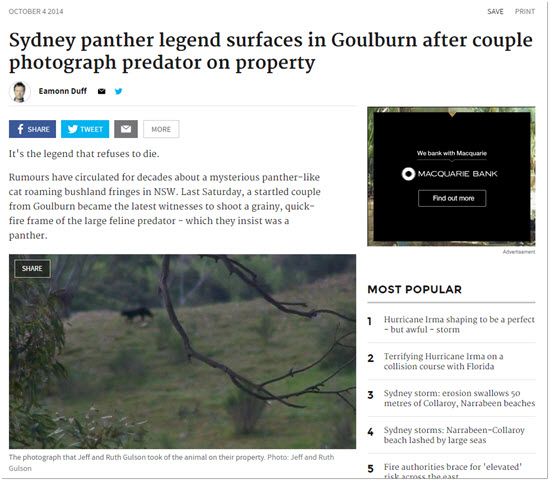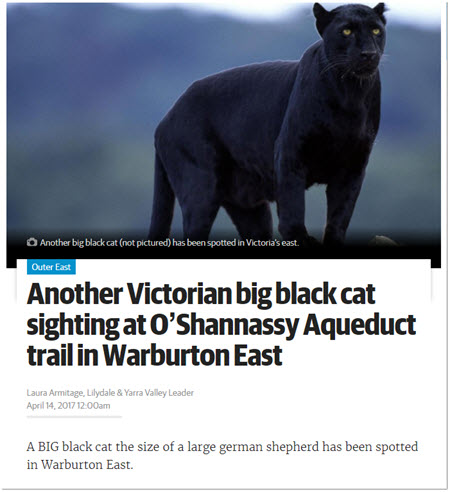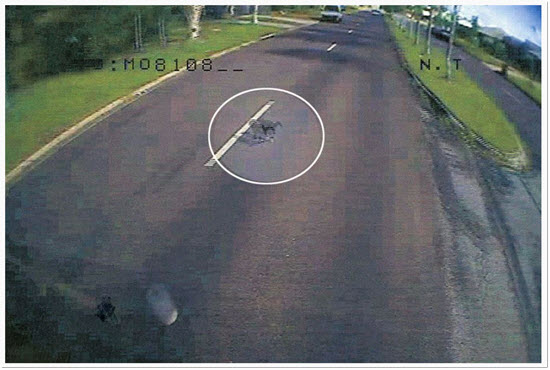Are there black panthers roaming the outskirts of Australia’s biggest cities? A lack of evidence, even after official investigations, doesn’t stop grainy photos and far-fetched stories making it into the news.
Rumours have circulated around Melbourne and Sydney for decades about foreign felines prowling the bush around the cities. Most commonly, locals spot a big black cat or panther — in New South Wales, the Penrith (also Blue Mountains) panther apparently roams around between the Blue Mountains and the Hunter Valley, and in Victoria, Gippsland and the Grampians have both been named as homes to mysterious big black cats.
The black cat reports and sightings have been making regular appearances in the news for decades. In both NSW and Victoria, the sightings became so regular that state authorities conducted investigations and reviews to see if they could track down the elusive creatures.

Both investigations reported back without finding any evidence — other than the eye-witness reports — that there were large felines in the bush. In 2012, the Arthur Rylah Institute investigated in Victoria, but found it “highly unlikely” there were black cats on the loose in Victoria. In 2014, a New Zealand invasive-species expert John Parkes, hired from across the ditch to look into NSW sightings, couldn’t find any evidence of felines, saying in his report:
“The sightings are mostly of black animals but the occasional reports of brown or tan cats suggest either more than one species is present or that people are mistaking other animals for cats. Large dogs, large feral cats or swamp wallabies have been suggested as candidates by some people.”
And yet, the reports continue. Just this year, reports have been rolling in from the Yarra Ranges in Victoria of big cat footprints, a big black cat the size of a German shepherd (not pictured), and, last year, two different cats at the same time in Melbourne’s outer east.

The big black cat legends are not unique to Australia. Many people are convinced they also roam Britain, with sightings collated by a group of amateur enthusiasts.
In Tasmania, it’s not a panther that gets punters reaching for the camcorders. In the bush of the island, you’re more likely to be calling The Mercury with blurry pictures of a Tasmanian tiger, than a big cat. There have been sightings reported since the death of the last thylacine in captivity, in 1936. Some video, released in early September, apparently shows a thylacine nudging a camera set up to capture the officially extinct creature, barking, and stalking around bushland.

And the Tassie tiger sightings aren’t limited to, well, Tassie. Scientists from James Cook University started field research in June on Cape York after what they said were credible sightings.
In Darwin, in 2010, a “monkey” was caught on a bus’ CCTV camera, prompting authorities to check with the local wildlife park all its primates were present and accounted for (they were), and advised it had probably been brought in illegally and could carry diseases. A few days later, the monkey had disappeared without any further sightings and head of Park and Wildlife Graham Phelps was telling the ABC they needed to wait for a more credible sighting, and there’s been nothing since.

There are various explanations for how foreign felines might have made their way into Australia. Some think they could have bred from animals released or escaped from circuses or zoos, while others believe they could have been the offspring of mascots for visiting US soldiers during World War II.








There are many more than you know of Emily. I remember the Taranah Tiger and the Meadow Flats monster. Of course we like the stories as long as we are not too nearby. Perhaps it is the lack of large dangerous animals in our own fauna. Every country has something, often with a grain of truth.
This is the only large land mass without a predator big enough to kill a person.
Perhaps the funnel webs wiped them out.
Whatever creatures are running around the back-blocks of Australia ain’t nothing compared to what’s running around the back-blocks in the minds of cryptozoologists. Whist engaged in bird photography recently I was in one of my favourite coups of rural forest when a man in a ute rolled up, .22 in a gun rack in the cab. Earnestly he asked if I was OK? Yes, I was fine. He looked doubtful. He told me there were panthers around there. I told him politely (since he was the one with the rifle) that in all my many visits to the area I had never seen one. Despite the grainy photostats of paw prints he then produced failing to convince me, we parted without shots being fired.
This is the same nuttery as the Bigfoot nonsense in the US: if one looks at a scatter-map of the sheer number of “credible” Bigfoot sightings over the past 60 years one is surprised Americans don’t bump into them at Walmart all the frigging time.
And is it not astonishing that, considering we have had good and cheap digital cameras now for 20 years, the photographs of Bigfoots, Thylacines and panthers remain firmly rooted in the grainy film past? Ever seen a nice clear digital photo of a Thylacine? Me neither.
It is said that during WW2 some US service regiments had Cougars as mascots, and that these might have been released into the bush after the war. Problem is there is no melanistic variety of Cougar – they are always brown, and Australians keep seeing black cats. Same with Bigfoot ancestry: what the Hell kind of anthropological provenance are THEY supposed to have on the North American continent?
What’s at the bottom of it? Heroism, attention-seeking, confusion, the age-old love of story-telling and scaring the shit out of each other, and perhaps a bit of rural mischief-making in order to create a tourism interest in a locality. Here in WA we have had over the years the Cordering Cat and the Nannup Tiger, and a few others I can’t recall.
There’s always idicocy, of course. Malcolm Roberts believed that a variation in grammar could save him from the gubmimt. I suspect believing in Australian panthers is a considerably lesser lunacy.
Nonetheless, if I am late back from my next trip will one of you call Mum?
If I notice you’re missing I’ll be sure to raise the alarm Graham R but do be careful…
it’s a jungle out there !
There is a very simple reason why all photographs and footage of thylacines in the wild appear blurry, and the only clear footage is the famous black and white clip of film of the so-called “last” Tasmanian Tiger that was in a zoo.
In the wild, the thylacine is a naturally blurry creature, but when kept in captivity its natural blurriness is shed onto the cage floor.
Simple really. When you know.
Thanks Mark. This information is worth the subscription!